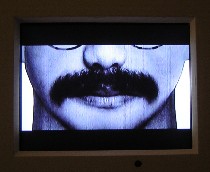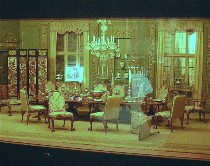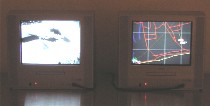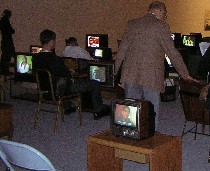
The television in your living room is a force of evil–the biggest enemy of truth in our world-wide culture today. At least, that’s the message I got from this year’s Carnegie International (it’s the 54th of this estimable triennial, by the way), which dipped it’s arty toe into international waters and found that a lot of artists feel like they and the world around them have been swept away in an ocean of lies via the tv screen. Belief systems–politics of all stripe, religious movements, big business and government have captured the storytelling aparatus of society to tell it like they want it to be.
Paul Chan’s “Now Let us Praise American Leftists” (image top) is a letterboxed video on a television screen showing faces from just above the tip of the nose to just above the bottom of the chin. All the faces were created in FACES, a computer program that helps law enforcement agencies create sketches of criminals. The idea of using stereotyping formulas in art is not so new, but the video was great to watch as it raised issues of preconceived notions about physiognomy, ethnicity and enemies of the state. Chan, a native of Hong Kong, now lives in New York.

Tiny, tiny television screens showing scenes of red coats at war in Revolutionary War era dollhouse rooms as well as broadcasts of other historic wars in other period rooms was Londoner Jeremy Deller‘s jab at how we get our news and whose point of view the so-called truthful news represents (“Breaking News,” image right).
 And Harun Farocki‘s three installations, “Eye/Machine I, II, and III,” each a pair of television screens, raise the issue of machine-interpreted vision, something we use increasingly in warfare to determine bombing targets. The imagery, full of crosshairs and explosions and control-panel views serve as chilling reminders of how tenuously machines render facts. The work was also a reminder that the American “precision” military strikes in Afghanistan and Iraq were a lie based on this kind of machine-mediated information. Was the bombed wedding really bombed or really a wedding? Farocki, born in Czechoslovakia, lives in Germany (left, from Farocki’s installation).
And Harun Farocki‘s three installations, “Eye/Machine I, II, and III,” each a pair of television screens, raise the issue of machine-interpreted vision, something we use increasingly in warfare to determine bombing targets. The imagery, full of crosshairs and explosions and control-panel views serve as chilling reminders of how tenuously machines render facts. The work was also a reminder that the American “precision” military strikes in Afghanistan and Iraq were a lie based on this kind of machine-mediated information. Was the bombed wedding really bombed or really a wedding? Farocki, born in Czechoslovakia, lives in Germany (left, from Farocki’s installation). Consistent use of television screens in art to raise these issues (see post below for a descripton of the Kutlug Ataman piece) is of course telling. Ataman’s piece, “Kuba” (detail, right), shows that you don’t have to go to a mosque or a church to hear a story to believe in. You can just turn on the tube in your living room, on your personal tv, amidst your most comfortable furniture, and society will beam in its version of the truth.
Consistent use of television screens in art to raise these issues (see post below for a descripton of the Kutlug Ataman piece) is of course telling. Ataman’s piece, “Kuba” (detail, right), shows that you don’t have to go to a mosque or a church to hear a story to believe in. You can just turn on the tube in your living room, on your personal tv, amidst your most comfortable furniture, and society will beam in its version of the truth.
 The more we stare into the moving box, the more removed we are becoming from our own personal interaction with and judgment of the real world, for certainly the “Real World” of television is anything but. What’s coming forth in “Joan of Arcadia” (left), “Will and Grace,” “Fear Factor” the nightly news or “The Jerry Springer Show” is a corporate projection for you to believe in–myth-making or religion for the 21st century. The tv–and the computer, which is close behind in claiming to project truth–is the high priest, and he’s taken up residence in your home, presenting mysteries and miracles edited–by producers, writers, cameramen, ideologues and honest men–to look like your truth .
The more we stare into the moving box, the more removed we are becoming from our own personal interaction with and judgment of the real world, for certainly the “Real World” of television is anything but. What’s coming forth in “Joan of Arcadia” (left), “Will and Grace,” “Fear Factor” the nightly news or “The Jerry Springer Show” is a corporate projection for you to believe in–myth-making or religion for the 21st century. The tv–and the computer, which is close behind in claiming to project truth–is the high priest, and he’s taken up residence in your home, presenting mysteries and miracles edited–by producers, writers, cameramen, ideologues and honest men–to look like your truth .










